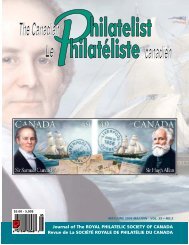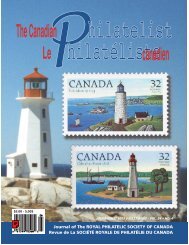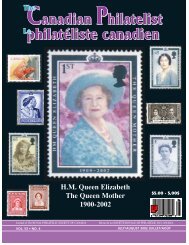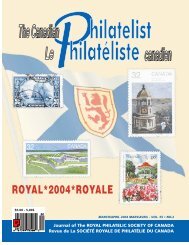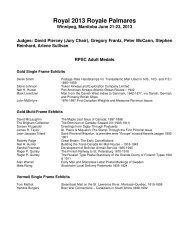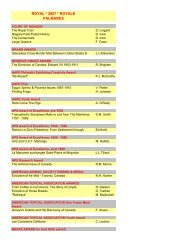GREENWOOD STAMP COMPANY â Since 1962 - The Royal ...
GREENWOOD STAMP COMPANY â Since 1962 - The Royal ...
GREENWOOD STAMP COMPANY â Since 1962 - The Royal ...
You also want an ePaper? Increase the reach of your titles
YUMPU automatically turns print PDFs into web optimized ePapers that Google loves.
Figure 2 maps the two scheduled coastal and three<br />
inland postal routes operating by 1901. Most interior<br />
routes developed after 1890, encouraged by growth<br />
of trade and administrative needs, several wars with<br />
Ashanti, and expansion of telegraphs. <strong>The</strong> following<br />
sections attempt to illustrate and reconstruct inland<br />
mail movement along these routes. Remarkably, the<br />
often unhealthy climate and primitive conditions<br />
did not appear to prevent carriers from moving<br />
mails reliably and on time!<br />
Mail Routes along the Coast:<br />
Figure 3. UPU Postcard carried westward<br />
from Elmina to Axim, 1892.<br />
Weekly mail routes are known from 1873. From<br />
Accra, the centre of government from 1877, western<br />
mails were carried to and from Axim, and by 1889<br />
service was expanded to half of Assinie bordering<br />
on French territory (Ivory Coast). This tri-weekly<br />
western service was using 18 mail carriers by 1888.<br />
<strong>The</strong> ½ d postcard in Figure 3 was carried 75 miles<br />
westward along coastal paths from Elmina to Axim.<br />
Based on the date-stamps on the card and published<br />
schedules for this route (Newroth, 1999), we can<br />
attempt to reconstruct the journey. <strong>The</strong> card was<br />
marked on Saturday Feb 6, 1892 and dispatched<br />
early the next day to Chama and Sekondi. From<br />
Sekondi it went through Adjuah to Dixcove on<br />
Monday, and from Dixcove at 05:00 Tuesday morning<br />
to arrive at Axim (25 miles away) at 17:00 that<br />
same day (Feb 9).<br />
Mails travelled eastward from Accra to Addah,<br />
then across the mouth of the Volta River, to Kwitta<br />
in a biweekly service 1875-1887. Triweekly mails<br />
using eight carriers began in 1888. Regular exchanges<br />
began in 1889 and linked Kwitta and German<br />
Togoland further east.<br />
Figure 4 shows double-rate registered mail from<br />
Axim to Kwitta, a distance of 261 miles along nearly<br />
Figure 4. 1892 Registered Mail carried eastward<br />
from Axim to Kwitta.<br />
the entire coast of the Colony. Using schedules for<br />
the Axim - Accra - Kwitta routes, this mail probably<br />
was dispatched from Axim on Tuesday, November<br />
1, 1892 (day after date-stamp) and arrived at Accra<br />
on Sunday, November 6. <strong>The</strong> next eastward dispatch<br />
from Accra was scheduled for Tuesday, with delivery<br />
at Kwitta at noon on Friday, November 11 (datestamp<br />
on reverse of cover).<br />
Special wrappers of at least two types were used<br />
for “free” official mail in the Gold Coast - probably<br />
the one shown in Figure 5 enclosed an issue of the<br />
Gold Coast Gazette. This mail was approved by<br />
signature of Mark Kerr, the Colonial Secretary, and<br />
is date-stamped July 3, 1895. It originated from<br />
Victoriaborg (a sub-office in Accra at government<br />
administrative buildings) and left Accra by the<br />
eastern coastal route on Thursday July 4, arriving at<br />
Kwitta at noon on Sunday, July 7.<br />
Figure 5. 1895 Book Post Wrapper sent to Kwitta.<br />
Mails in the Eastern Interior:<br />
In 1887 the first regular interior mail route began<br />
overland from Accra to Kpong and Akuse, on the<br />
Volta River, connecting by boat down river to Ada<br />
at its mouth. This “mountain” route followed paths<br />
long used by European missionaries and natives,<br />
ascending to villages on a ridge of about 1500 feet<br />
JF06 • the CP / le PC • 35



